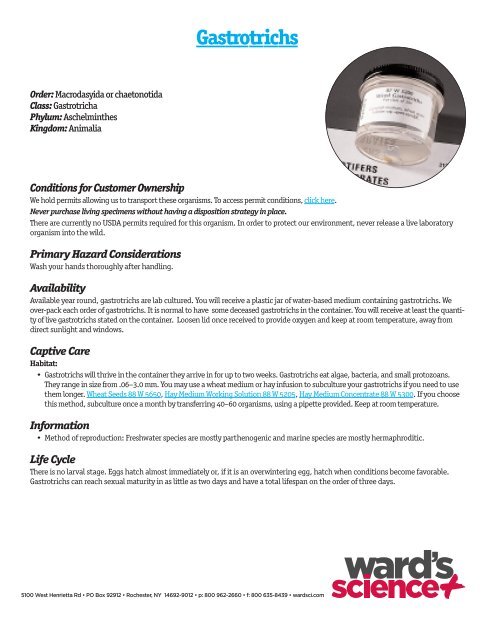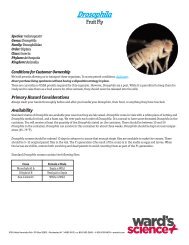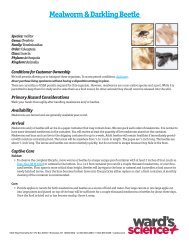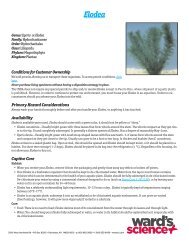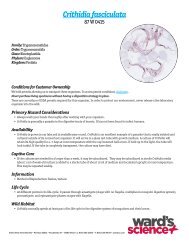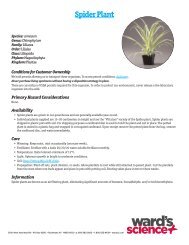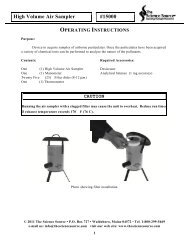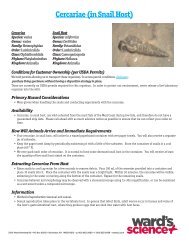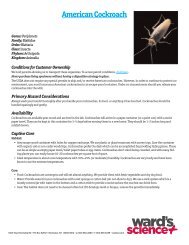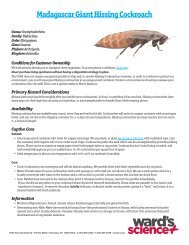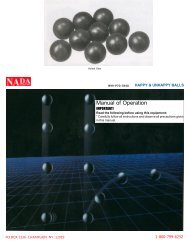Gastrotrichs - Sargent Welch
Gastrotrichs - Sargent Welch
Gastrotrichs - Sargent Welch
Create successful ePaper yourself
Turn your PDF publications into a flip-book with our unique Google optimized e-Paper software.
<strong>Gastrotrichs</strong><br />
Order: Macrodasyida or chaetonotida<br />
Class: Gastrotricha<br />
Phylum: Aschelminthes<br />
Kingdom: Animalia<br />
Conditions for Customer Ownership<br />
We hold permits allowing us to transport these organisms. To access permit conditions, click here.<br />
Never purchase living specimens without having a disposition strategy in place.<br />
There are currently no USDA permits required for this organism. In order to protect our environment, never release a live laboratory<br />
organism into the wild.<br />
Primary Hazard Considerations<br />
Wash your hands thoroughly after handling.<br />
Availability<br />
Available year round, gastrotrichs are lab cultured. You will receive a plastic jar of water-based medium containing gastrotrichs. We<br />
over-pack each order of gastrotrichs. It is normal to have some deceased gastrotrichs in the container. You will receive at least the quantity<br />
of live gastrotrichs stated on the container. Loosen lid once received to provide oxygen and keep at room temperature, away from<br />
direct sunlight and windows.<br />
Captive Care<br />
Habitat:<br />
• <strong>Gastrotrichs</strong> will thrive in the container they arrive in for up to two weeks. <strong>Gastrotrichs</strong> eat algae, bacteria, and small protozoans.<br />
They range in size from .06–3.0 mm. You may use a wheat medium or hay infusion to subculture your gastrotrichs if you need to use<br />
them longer. Wheat Seeds 88 W 5650, Hay Medium Working Solution 88 W 5205, Hay Medium Concentrate 88 W 5300. If you choose<br />
this method, subculture once a month by transferring 40–60 organisms, using a pipette provided. Keep at room temperature.<br />
Information<br />
• Method of reproduction: Freshwater species are mostly parthenogenic and marine species are mostly hermaphroditic.<br />
Life Cycle<br />
There is no larval stage. Eggs hatch almost immediately or, if it is an overwintering egg, hatch when conditions become favorable.<br />
<strong>Gastrotrichs</strong> can reach sexual maturity in as little as two days and have a total lifespan on the order of three days.
Wild Habitat<br />
Different species of gastrotrichs live in saltwater and freshwater environments in tropical and temperate climates. They are a major<br />
food source for many aquatic species, especially tubelarians, insects, and small crustaceans.<br />
Special Notes<br />
The name means “hairy stomach” and refers to the cilia covering its underside, enabling it to glide over surfaces. <strong>Gastrotrichs</strong> have a<br />
primitive nervous system and ciliary sense organs.<br />
Disposition<br />
• Please dispose of excess living material in a manner to prevent spread into the environment. Consult with your schools to identify<br />
their preferred methods of disposal.<br />
• You can safely use one of the following methods:<br />
• Treat culture with a 10% bleach solution for 24 hours (1 part bleach to 9 parts culture medium or water culture medium removed).<br />
Then rinse bleach solution down the drain with water until you can no longer smell bleach. Rinse remaining materials and containers<br />
with water and dispose of them in a general garbage container.<br />
• Carefully wrap specimens and their containers in a biohazard bag (without containing anything sharp that might puncture the<br />
bag) and tie closed (a twist tie works well). Autoclave the bag for 30 minutes at 121°C and at a pressure of 15 lbs. per square inch.<br />
Dispose of autoclaved bag as your school recommends.<br />
© 2008 Ward’ s Science. All rights reserved. Rev. 9/08, 11/09, 3/13


